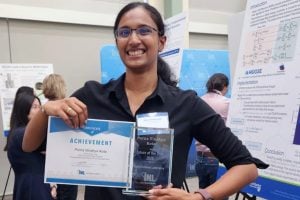
This summer, civil and systems engineering doctoral student, Purna Vindhya Kota, had the opportunity to travel across the U.S. to apply her computational mechanics background to additive manufacturing research at Idaho National Laboratory (INL). Credited with creating the first nuclear propulsion systems for Navy submarines and aircraft carriers, INL is a premier research institution in Idaho dedicated to nuclear research, integrated energy systems and security solutions.
As a graduate of the Indian Institute of Science in Bangalore, and current doctoral candidate, Kota now focuses on research to develop machine-learning–based surrogate models that predict material response. She said it was this foundation that made her an ideal fit for the internship with INL, where she explored new approaches to model the latest additive manufacturing processes for metal alloys.
“I was particularly interested in applying to INL because of its blend of high-performance computing and materials research,” said Kota. “The chance to combine mechanics, machine learning, and national lab resources was an incredible opportunity.”
“My role was centered on building and using new deep learning surrogate models that accelerate simulations in additive manufacturing,” Kota said. “I also built an active learning pipeline that could integrate uncertainty quantification so users could reduce the need for time-consuming physics-based simulations.”
In addition to running large-scale experiments using the lab’s high-performance computing systems, Kota worked closely with her INL mentors to relay progress on her deep learning models through technical reports, presentations, and poster sessions.
Kota says her doctoral coursework at Johns Hopkins has been integral to her research at INL. “The skills I’ve gained, particularly in modeling and data-driven analysis, were invaluable. They gave me the perspective and tools needed to make sure the models I created weren’t just accurate, but reliable for real-world applications,” she said.
For Kota, one of the highlights of the summer was INL’s collaborative environment. She worked with a diverse group of researchers whose focus areas included computational science, engineering, mathematics, and physics, and gained a deeper understanding of how interdisciplinary efforts are essential to solving current engineering challenges.
Kota’s contributions at INL did not go unnoticed. During her time with the organization, she received the Intern of the Year Award, an honor that highlighted both her impact and potential.
Outside of her laboratory work, Kota took advantage of Idaho’s scenic landscape by hiking in its national parks, which provided a welcome balance.
For other students who hope to complete an internship during their program, Kota encourages them to be proactive and confident when seeking opportunities.
“Don’t be afraid to apply, even if you think you might not meet every criterion,” she said. “Internships are about learning, and being able to ask good questions is just as important as having the right answers. These opportunities can really help shape your future career path.”
In terms of her own career path, Kota considers her time at INL as pivotal to her development.
“This experience made me even more excited about bringing mechanics and AI together, and it emphasized how important it is to connect advanced computing with real engineering problems,” she said. “Whether I end up at a national lab, in academia, or in industry, I want to keep working at the intersection of these fields and see how I can use computation and AI to solve real-world challenges.”